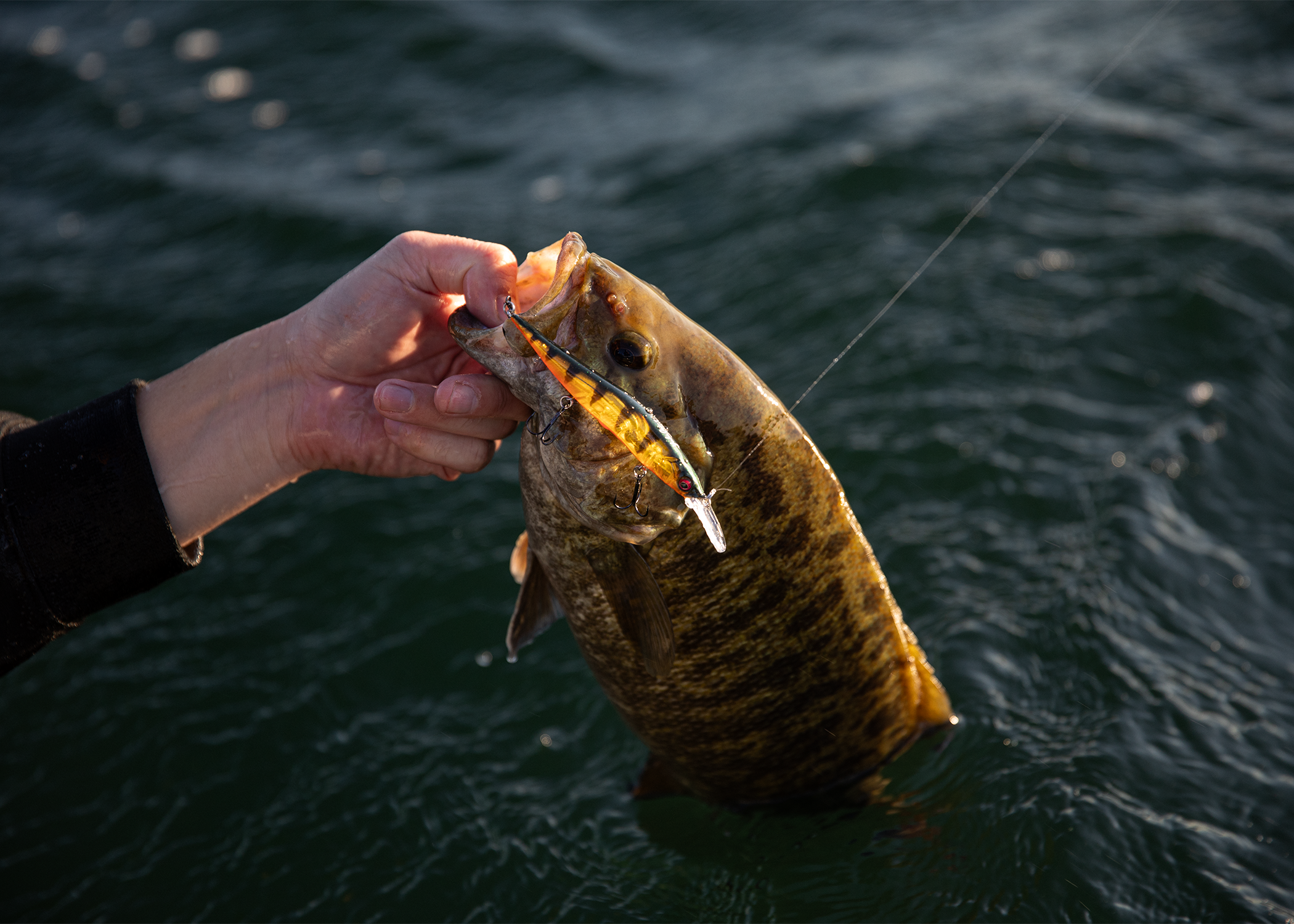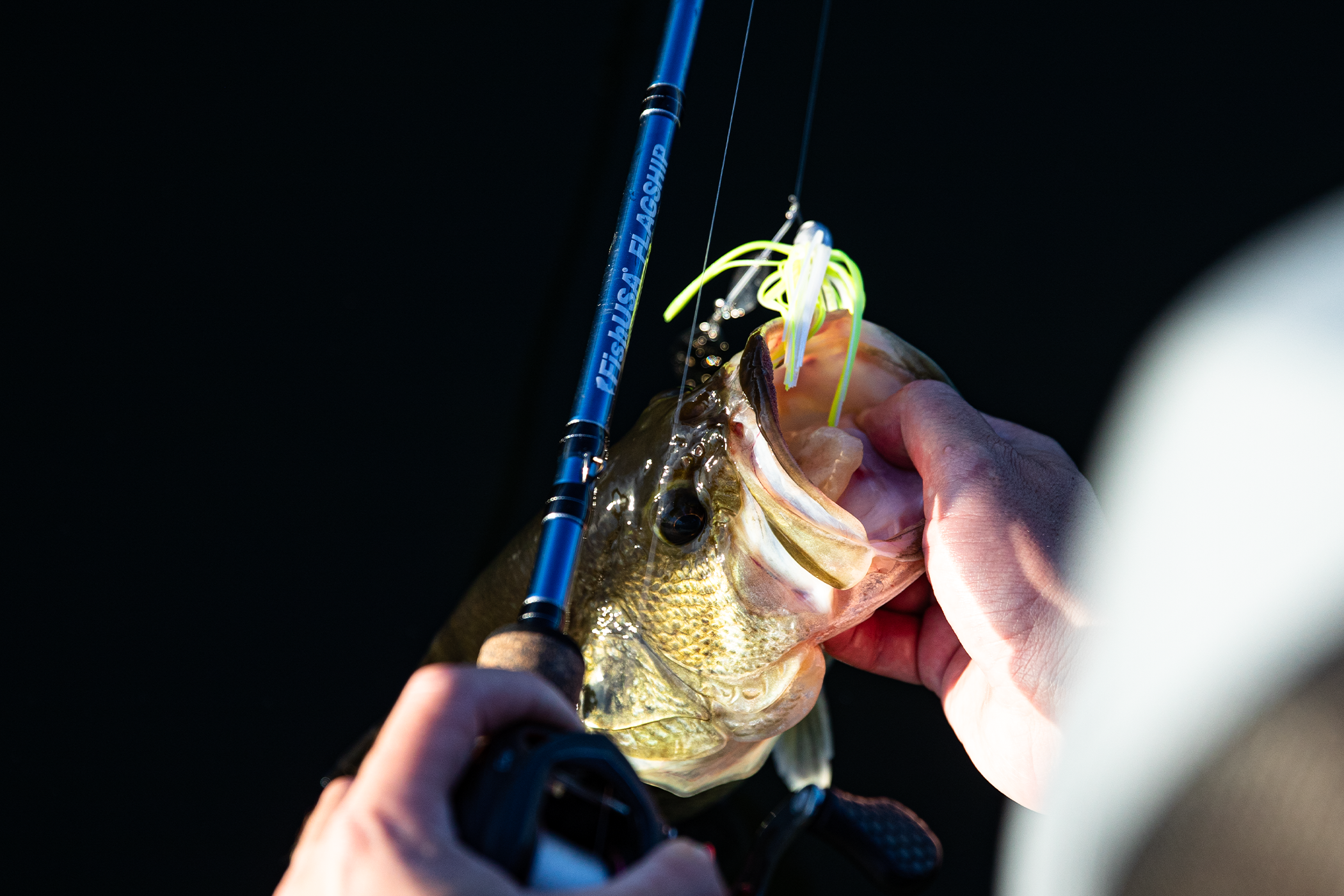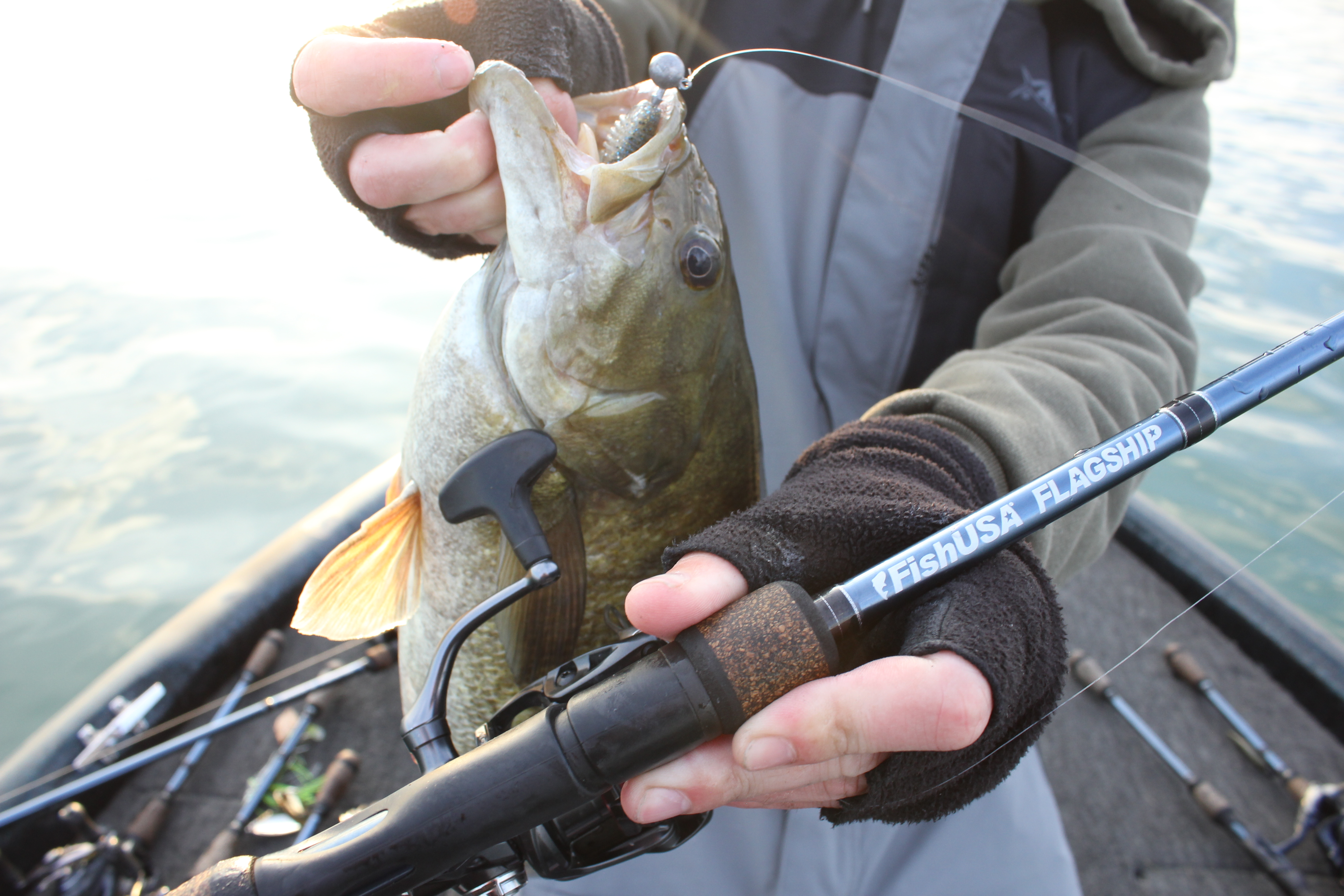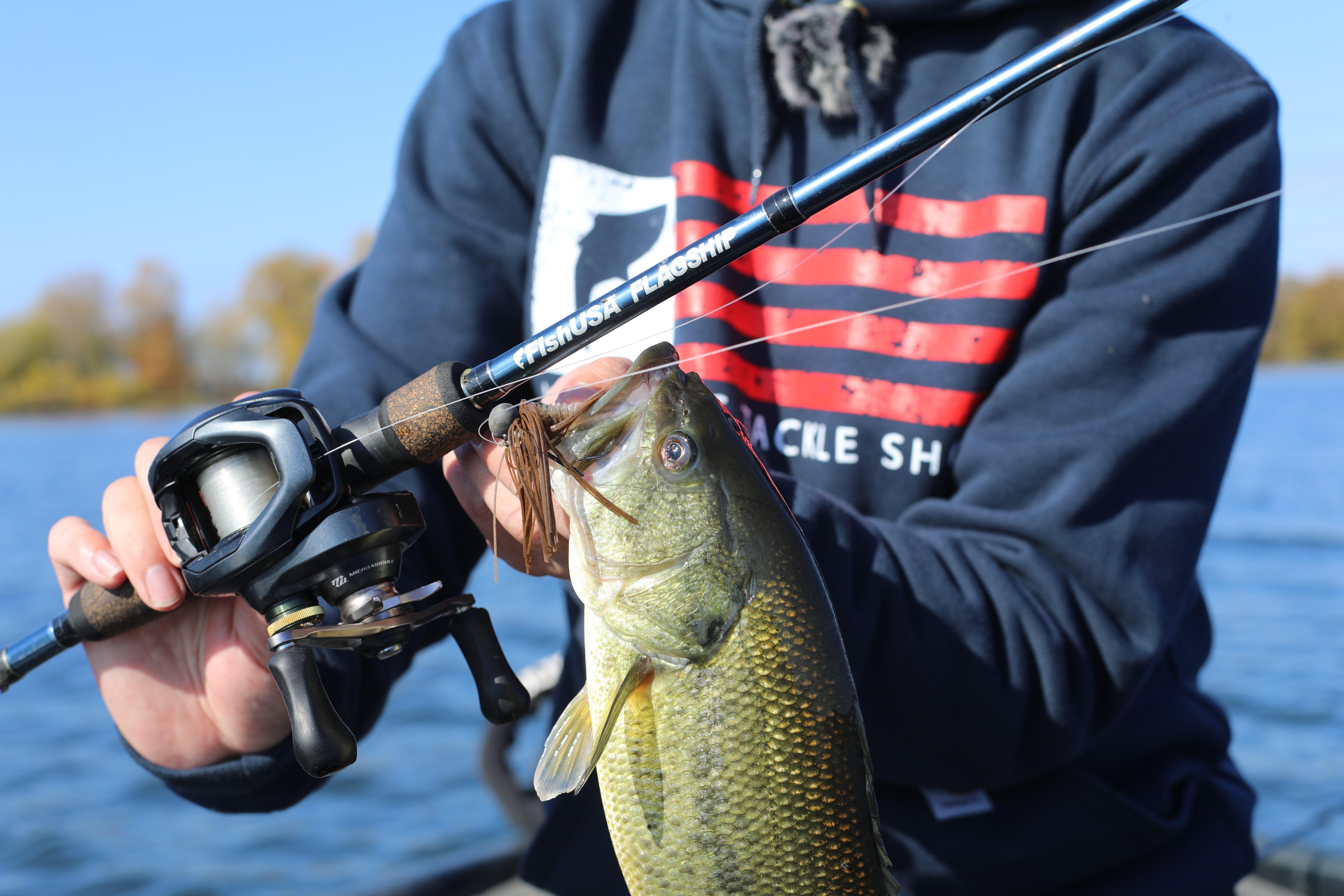The Best Bass Fishing Retrieval Methods for Different Lures & Conditions
By: FishUSA Staff
November 25, 2025
If you’re searching for the best bass fishing retrieval methods, you already know lure choice is only half the equation. The real difference-maker is how you move that lure—your cadence, speed, pauses, and deflections. Raise a squarebill just two inches, extend a jerkbait pause by two seconds, or rip a lipless free from grass a beat sooner and you’ll watch followers turn into biters. This guide translates vague advice like “slow down” into precise, repeatable retrieves organized by lure type and real-world conditions—season, water clarity, wind, grass, wood, and current. Along the way, you’ll dial in line and IPT (inches per turn)/gear ratio so you can command speed, depth, and action—and leave the lake with a pattern you can repeat.
If you’re searching for the best bass fishing retrieval methods, you already know lure choice is only half the equation. The real difference-maker is how you move that lure—your cadence, speed, pauses, and deflections. Raise a squarebill just two inches, extend a jerkbait pause by two seconds, or rip a lipless free from grass a beat sooner and you’ll watch followers turn into biters. This guide translates vague advice like “slow down” into precise, repeatable retrieves organized by lure type and real-world conditions—season, water clarity, wind, grass, wood, and current. Along the way, you’ll dial in line and IPT (inches per turn)/gear ratio so you can command speed, depth, and action—and leave the lake with a pattern you can repeat.
Shop our Selection of Bass Fishing Rods and Bass Fishing Reels
Table of Contents
- Retrieval Fundamentals: The Four Levers
- Quick Picks: Conditions → Go-To Retrieve
- Crankbaits: From Squarebills to Deep Divers
- Jerkbaits: Temperature-Driven Pauses
- Spinnerbaits & Chatterbaits: Blades That Talk
- Swimbaits: Paddletails, Glides & Big Softs
- Jigs & Texas/Carolina Rigs: Bottom-Contact Masters
- Topwater: Walkers, Poppers, Props & Buzzbaits
- Frogs, Toads & Punch Rigs: Heavy Cover Playbook
- Finesse & Vertical: Ned, Dropshot, Neko & Damiki
- Special Situations: Current, Mud & Post-Front
- Dialing With Electronics & Clues
- Gear That Controls Retrieve: Rod, Line & Reel Speed
- Troubleshooting: Follows, Short Strikes & Grass Gunk
- FAQs — Best Bass Fishing Retrieval Methods
- Conclusion: Dial the Retrieve, Unlock the Bite
Retrieval Fundamentals: The Four Levers
Cadence is your rhythm. Think of the difference between twitch–twitch–pause and a steady grind; both can be right, but only one matches the fish’s mood. Cadence includes how sharply you move the rod tip, how often you interrupt motion, and how long you let the bait hang or fall. Subtle changes—one extra twitch, a longer stall, or a softer sweep—often flip neutral fish into biters.
Speed isn’t simply “fast or slow.” It’s governed by your reel’s inches-per-turn (IPT), spool fill, and how quickly you rotate the handle. Cold water and pressured fish generally want slower presentations; active summer fish and wind-driven shad schools can demand a bursty, accelerated retrieve. Use IPT to standardize speed so you can repeat what worked.
Depth control is a function of countdown time, rod-tip angle, line choice (braid floats, fluoro sinks, mono stretches), and the lure’s natural buoyancy. You can run the same bait at distinctly different layers by adjusting those variables—and the fish will tell you which layer is right when your bait starts getting checked or eaten.
Deflection/contact is the strike trigger most anglers underuse. Ticking stalks, grinding rock, and glancing off wood send a shock into the bait that looks like a fleeing or wounded prey item. Plan contact points on your cast, then build a tiny stall or speed-up immediately after the deflection to convert curiosity into commitment.
Pro move: Open a new area with a neutral, steady retrieve for a minute to establish baseline. Next run a stop-and-go, then a burn-and-kill, then a sweep-and-fall. One of those three almost always gets the first honest read on fish mood.
Quick Picks: Conditions → Go-To Retrieve
Cold & clear (late winter): Start with a jerkbait using a deliberate twitch–twitch–long pause of five to fifteen seconds. The pause is the bite—watch the line and resist the urge to move too soon.
Cold & stained: Swap to vibration and presence. Slow-roll a spinnerbait until you feel a steady thump, or run a squarebill to deliberately bump cover and stall for a heartbeat after the deflection.
Post-spawn shad spawn: Keep a swim jig crawling just above the grass with a measured slow roll while a walking topwater gets short, crisp stalls anytime it crosses a bait flicker or shade seam.
Summer grass (mid-day): With a chatterbait, let the blade tick grass and rip it free—most bites happen as it surges forward. Over holes and lanes, a frog that short-walks in place is deadly.
Fall shad blitz: Match fleeing bait with a lipless burn-and-kill—two seconds fast, half-second dead. Mid-depth cranks shine on a steady retrieve punctuated by micro twitches.
Muddy after rain: Choose thump. Colorado-blade spinnerbaits and chatterbaits on a patient slow roll excel. In skinny water, squarebills that collide with cover and pause are hard to beat.
Bluebird post-front: Downsize and finesse. A Ned rig doing an almost do-nothing drag, a dropshot with a slack-line quiver, or a glide bait that stalls by shade can coax conditioned fish.
Windblown banks: Use the wind to your advantage. Burn a spinnerbait near the surface to ride the chop, and shorten jerkbait pauses so the lure maintains tension in pushy water.
Current seams: Retrieve with the flow to keep a natural angle, stall in the eddy pocket, then sweep across the seam. A chatterbait that tracks across the divide often triggers the dominant fish.
Crankbaits: From Squarebills to Deep Divers
Squarebill (0–6 ft): Bump, Deflect, and Stall
The squarebill’s superpower is controlled chaos. Grind it steadily into shallow wood or rock until it glances off, then stall for one to two beats to mimic a stunned baitfish. In stained water, add a touch more speed to increase vibration, but preserve the stall—it’s the moment when tracking bass overrun the bait. Pair with a M/MF glass or composite rod and a 5.3–6.6:1 reel; use mono for more float or fluoro to pin it slightly deeper.
Mid-Depth (6–12 ft): Steady + Micro Twitches
At mid-depth, the most consistent producer is a smooth, even pull punctuated by tiny rod-tip ticks every five to eight handle turns. Those micro twitches interrupt the cadence just enough to suggest a nervous, living target. When your bill starts kissing a hard spot or transitions from clay to rock, briefly kill the bait and then resume the steady pace. Ten to twelve-pound fluoro adds depth without overwhelming the lure’s action.
Deep Divers (14–25 ft): Long Pull, Slow Roll
Big-billed divers like pressure. Sweep the rod to load the bill and drive the lure down, then slow-roll with the handle to maintain contact along ledges or shell beds. When you feel a lip, ridge, or unusually hard patch, pause cleanly and reengage. Deep divers pair well with composite/moderate rods that keep trebles pinned during long fights.
Lipless Cranks: Yo-Yo or Burn-and-Kill
On grass flats, the classic is a yo-yo: let the bait fall on semi-slack, rip it free as soon as it ticks grass, and watch the line for jumps on the drop. During shad chases, burn the bait to make the school panic, then kill it abruptly—predators often crush it in the vacuum the stop creates.
Tip: If you’re losing fish mid-fight on trebles, soften the system: go to a M/MF composite rod or add a short mono leader to reintroduce a bit of stretch.
Jerkbaits: Temperature-Driven Pauses
Cold & Clear: Patience Pays
In frigid, transparent water, the pause length decides everything. Work a deliberate twitch–twitch–pause and let the bait hang five to fifteen seconds. Fish that follow and stare need even longer hangs. Eight to ten-pound fluoro helps true suspenders maintain depth and keeps the nose down between twitches.
Cool/Stained: Shorten Pauses, Add Creep
As stain and temperature rise, shorten the pauses and sneak in a single handle turn after your twitches so the bait creeps forward. On windblown points, fish are already primed; quicken the cadence slightly to keep the bait from drifting slack and to provoke swatting strikes.
Warm Water: Aggressive Slash
In warm water, you can get loud. Slash the bait with three sharp twitches, give it a short breath, and repeat. Add speed bursts when you see bait skipping ahead of the lure. If the bait is a slow riser, avoid long pauses that let it float out of the strike window.
Buoyancy check: True suspenders reward patience; slow risers prefer shorter rests so they don’t climb out of the zone.

FishUSA Exclusive “Great Lakes Perch” color Megabass Vision Oneten +1 Jr.
Spinnerbaits & Chatterbaits: Blades That Talk
Spinnerbait
When the water is cold or stained, slow roll until you can feel each blade thumping—keep the lure just over bottom where fish relate to the contour. In windy fall conditions or around shad schools, burn the bait just under the surface and “kill” it at ambush points like dock corners or bush tips. Along steep banks and timber, let the bait helicopter on a controlled fall; pay attention—many eats happen on that descent.
Chatterbait (Bladed Jig)
In grass lanes, let the blade tick a strand and rip it free; the sudden surge is a primary trigger. Over stumps and isolated wood, keep a steady pace but add rod-tip pops to change vibration signature, then kill the bait after a bump. Tune the trailer: a boot-tail lifts and slows the retrieve for a thumpy profile, while a thin split tail lets you speed up with tighter vibration.
Gear: Chatterbaits excel on a MH/Mod-Fast composite that cushions surges; spinnerbaits feel great on a MH/F. A 6.8–7.3:1 reel allows both slow roll and quick burn.

Swimbaits: Paddletails, Glides & Big Softs
Paddletails (Keitechs, etc.)
Count down to the desired depth and then slow roll just fast enough to keep the tail working and the head tracking true. Over gravel and shell, a bottom-crawl—steady with occasional six- to twelve-inch lifts—keeps you in contact while suggesting a feeding baitfish. Across submerged grass, a burn-and-kill draws ferocious reaction strikes at the exact moment you kill the bait above a hole or lane.
Glide Baits
Most glides shine on a slow S-curve that’s barely fast enough to hunt. Add a half-turn pop to dart off center, then stall in shade or near wood to give followers a window to eat. Finish with an “L-turn” at the boat to convert trailers that won’t commit mid-retrieve.
Big Softs (Hudds, line-throughs)
On points and ledges, a lift-and-fall approach keeps the bait in the strike zone without racing. If fish track but won’t commit, dead-stick momentarily—many big bites happen when the bait appears to falter. Match your rod power to the bait’s weight and consider slightly more moderate actions with mono or a short leader on treble-rigged swimbaits to avoid tearing hooks free. Fluoro helps paddletails stay down.

Jigs & Texas/Carolina Rigs: Bottom-Contact Masters
Football Jigs (rock, shell)
Drag until you feel the jig tick and then give a short hop when you locate a hard spot. Use sweep sets on pressure—don’t jerk. In current, present quartering to the flow and let the jig walk down the line while you guide it with rod-leading sweeps.
Compact Flipping Jigs
Pitch, let the bait fall naturally, then shake in place before a controlled double hop. Many fish sit on the first two to three feet of bottom near cover, so don’t rush the pickup—work that short zone thoroughly before re-pitching.
Texas Rigs
Through sparse grass, a swim-and-glide keeps you above snags while still presenting a natural fall through openings. On vertical timber, lift and drop on the sunny side first, then trace the shaded edge—bass often pin prey against the trunk. Light pegging keeps the cone weight tight to the bait in grass so your fall is predictable.
Carolina Rigs
Use a long, patient sweep, then reel to catch up and feel for bottom changes. Pause on shell or where a soft bottom gives way to gravel—the transition is your strike zone. Heavy leaders and buoyant plastics can keep the bait hovering temptingly just off bottom.
Gear: Choose MH/H-Fast rods with 7.1–8.1:1 reels for quick line pickup. Fluoro maximizes feel; in heavy grass, braid with a leader maintains control.

Topwater: Walkers, Poppers, Props & Buzzbaits
Walking Baits
In calm water, a wide, unhurried walk punctuated by stalls near bait flickers or shade lines is devastating. Around schooling fish or in wind, tighten the walk and speed up, then kill the bait after a missed blowup to give the fish a second shot.
Poppers
On slick mornings, work a distinct pop–pause with two- to five-second rests; the pause lets rings radiate and sells the illusion of vulnerability. With a light chop, use pop–pop–pause to maintain presence without overwhelming the surface texture.
Prop Baits
Post-spawn, short chugs and long stalls around bluegill beds and shade lines tease defensive bass. The props add flash without forcing you to move the bait far, letting you milk high-percentage targets.
Buzzbaits
Begin reeling before the bait lands so it planes instantly, then maintain a steady wake. If a fish follows to the boat without striking, kill the bait and let it sink a beat—many finally commit on that flutter.
Line:Mono or braid + mono leader adds just enough cushion to keep trebles and single hooks pinned on the surge. A MF rod helps prevent pull-outs.
Frogs, Toads & Punch Rigs: Heavy Cover Playbook
Hollow-Body Frogs
Across cheese mats, a steady crawl keeps the bait visible and moving, but the magic happens over holes and lanes where you can short-walk in place and tempt fish hiding below. After a missed blowup, kill the frog, wait for a tick, then offer tiny twitches—the bass often circles back.
Toads (buzz frogs)
Run a straight, fast retrieve along edges to trigger ambush strikes; pause in lanes or gaps to let fish locate the sound. A lighter wire hook and high-floating plastic can help plane quickly in tight lanes.
Punch Rigs
Efficiency wins. Punch through, let the bait fall, give it a single shake, then pick up and re-drop. High repetition across multiple holes is more productive than overworking any single pitch.
Gear: Use H/XH rods, 50–65 lb braid, and 7.3–8.1:1 reels. Keep the tip high when walking a frog; set hooks on feel, not the splash.
Finesse & Vertical: Ned, Dropshot, Neko & Damiki
Ned Rig
A true do-nothing drag—literally letting the bait stroll while you maintain light tension—often outfishes more active moves. When fish sulk, add a shake-and-dead-stick or a swim-glide-shake to alter posture without overworking the bait. During cold fronts, smaller hops and longer rests outproduce flashy motions.
Dropshot
Think in centimeters. A tight-line shake keeps the bait quivering in place; a nose-down hover mimics feeding. For deep fish, keep the lure at eye level and use a slack-line quiver to make the plastic breathe without moving far horizontally.
Neko/Wacky
Don’t rush the fall—the shimmy is the strike trigger. After the initial drop, lift once to reanimate the bait and then dead-stick near shade or dock cables. Many bites feel like simple weight—lean and reel.
Damiki/Moping
Hover the bait just above the fish you see on sonar, introduce a micro quiver, and slowly pull away when they stare. That escape cue often forces a commitment.
Gear: Pair ML/XF spinning with light braid and a fluoro leader. Favor slower IPT to maintain precise control.

Special Situations: Current, Mud & Post-Front
Current seams: Present with the flow to keep a natural angle; pause in eddies where fish rest, then sweep across the seam to trigger reaction. Keep the rod leading so you feel the bait track the seam edge.
Muddy water after rain: Choose thump and presence. Slow-roll a spinnerbait or chatterbait so the fish can find it by feel, and use a squarebill to make deliberate, audible collisions with shallow cover followed by a short stall.
Bluebird post-front: Downsize profiles and dead-stick more. Alternatively, grind a super-slow roll along first breaks with a bladed bait—the subtle thump can coax bites when nothing else will.
Dialing With Electronics & Clues
Let your sonar dictate retrieve style. Suspended arcs respond to glide-and-pause or a bait that rises and stalls in their lane; fish pinned to bottom want a drag or short hop that stays in contact. On the surface, watch wind lanes, birds, and bait dimples. When life gathers, switch to burn-and-kill or stop-and-go retrieves that imitate a panicked school. Use a simple 10-cast test: change only one variable—speed, pause, or rod action—every ten casts. Log what earns follows versus eats and iterate toward the latter.
Gear That Controls Retrieve: Rod, Line & Reel Speed
Your rod’s action should mirror your hook style. Treble-hook baits belong on Moderate/Mod-Fast actions that cushion surges and keep small points buried; single-hook presentations need Fast/Extra-Fast to drive steel home with authority. Line choice fine-tunes behavior: braid rips baits free of grass and shines on topwater walking (add a mono/fluoro leader for cushion), fluoro adds sensitivity and depth control for bottom contact, and mono offers stretch that protects trebles and enhances surface action. Finally, match reel speed to task—5.3–6.6:1 for controlled cranking and trebles, 6.8–7.3:1 as the versatile middle ground, and 7.5–8.5:1 when you must pick up slack fast for jigs, frogs, and punching. If you standardize IPTs for your favorite cadences, you can reproduce a bite window anywhere.
Internal links to add: Rods by action (glass/composite for cranks; MH/F for jigs), line hubs (braid/fluoro/mono), and a guide on IPT vs gear ratio.
Troubleshooting: Follows, Short Strikes & Grass Gunk
Too many follows usually means the fish want a kill window. Insert a longer stall, change trailer buoyancy to alter hover, or downsize the profile to reduce intimidation. Short strikes often signal an overly stiff system—soften your rod or add a short mono leader and slow the cadence so the bait stays in their mouth longer. If grass constantly fouls, raise the rod tip to skim the tops, rip the bait free sooner, and consider thinner braid or a more compact lure that slices stalks cleanly.
FAQs — Best Bass Fishing Retrieval Methods
What’s the best retrieve in muddy water?
Choose thump and presence: spinnerbaits on a slow roll, chatterbaits steady with subtle rod-tip pops, and squarebills that deflect and stall on shallow cover. Quick pick: slow down and increase vibration.
How long should I pause a jerkbait in winter?
Start at 5–10 seconds and extend to 15 on followers or ultra-clear water. If fish nip and leave, shorten the pause slightly so the bait doesn’t feel dead.
Do I burn or slow roll a spinnerbait in fall?
When shad are up and wind is pushing bait, burn near the surface and kill around ambush points. In calm or stained conditions, slow roll along deeper contours.
What chatterbait retrieve works in grass?
Use tick-and-rip: let the blade kiss grass, snap it free, and be ready—the bite often comes as it surges forward. If they short-strike, add a brief pause after the rip.
How do reel gear ratios affect retrieves?
Lower ratios (5.3–6.6:1) add control for trebles; mid (6.8–7.3:1) covers most tasks; high (7.5–8.5:1) vacuums slack for jigs, frogs, and punching. Match IPT to your target cadence.
Best lipless crankbait retrieve in spring?
Yo-yo across warming grass: rip free and let it fall on semi-slack. In shad-driven chases, a burn-and-kill across points can outpace competitors.
Right frog cadence on mats vs edges?
On mats, use a steady crawl and short-walk in place over holes; on edges, walk with longer stalls near lanes and shaded pockets.
How do I retrieve a glide bait for followers?
Maintain a slow S-curve, deliver a half-turn pop, and stall by shade or wood. Finish with a boatside L-turn to convert trailers.
Is yo-yoing a lipless better than steady in cold water?
Often yes—the fall triggers lethargic fish. If they still refuse, try a slow, steady roll just above the grass tops.
What post-front retrieve works in clear water?
Go finesse with a Ned do-nothing or a dropshot slack-line quiver, or grind a super-slow roll along first breaks with a bladed bait.
Conclusion: Dial the Retrieve, Unlock the Bite
The best bass fishing retrieval methods shift with water temperature, clarity, and cover, but the framework never changes: match cadence to mood, speed to season, and deflection/contact to the cover you’re fishing. Begin neutral, test three cadences quickly, and let bites—and even sniffs or follows—steer small adjustments in pause length, IPT, and rod action. Do that consistently and you’ll turn “just follows” into fish in the net. Save the retrieval cheat sheet, practice two cadences this week, and share your lake conditions and winning pattern in the comments so other anglers can learn from your dial-in.
Shop Bass Tackle & Gear

